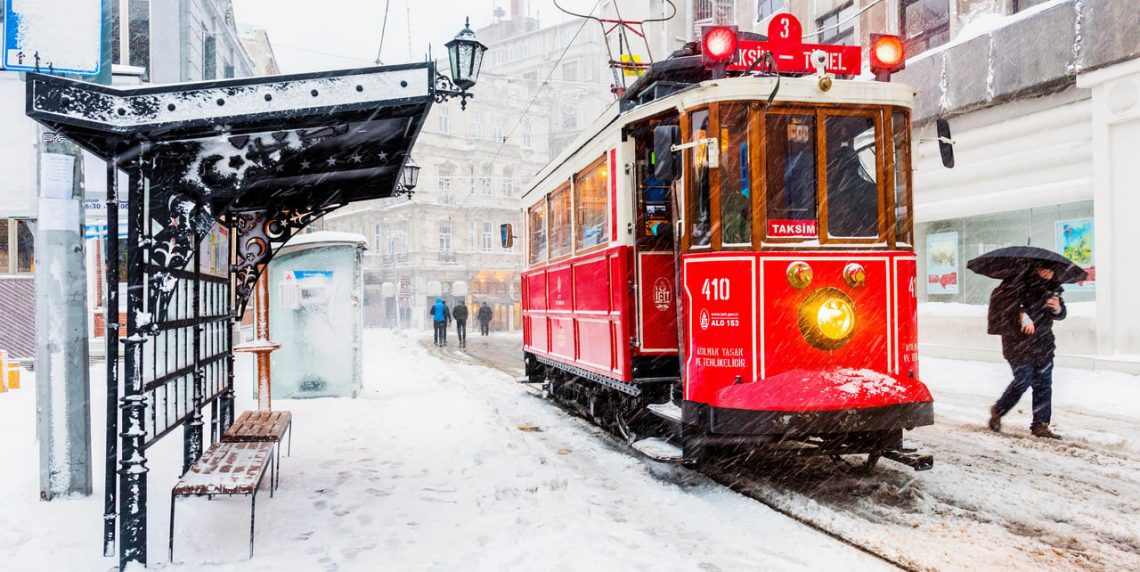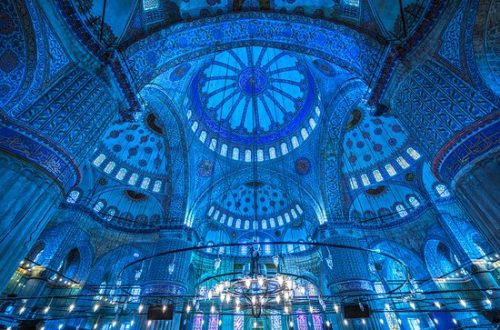
Istanbul in winter
Is Istanbul a good travel destination in winter?
What is the weather in Istanbul in winter, like in December, January and February? What can I do and not do? How much is going on?
Here are my answers about the “cold” season as well as some useful travel tips.
I will start with the most frequent question, then come to the most important travel tips, pictures from Istanbul during the winter months and a suggested route through the city.
What is the weather like in December, January and February in Istanbul?
When I am in Istanbul, I unpack my sweaters in mid-November and put them back in the closet at the end of March.
I cannot promise you that you will stroll through Istanbul during winter with short sleeves, no jacket and sunglasses. The exact opposite is also possible.
Sometimes in December it is 20 ° on one day, followed by a day with rain. Snow very rarely falls in Istanbul. This usually only happens once a year. For years, I’ve wanted to take a photo of Hagia Sophia in snow and I still haven’t succeeded.
Istanbul in winter, it is very rarely colder than 10 °.
Do not confuse the climate on the Bosporus with the Turkish Riviera (Antalya). There, it is often still 25 ° warm during the day throughout December, January and February.
Compared to other European cities, Istanbul is definitely among one of the warmest travel destinations.
Well packed: pack a rain jacket and sweater in winter. Before you leave, take a quick look at the weather report. In addition, a hood or a thick jacket may be necessary. My girlfriend wears a thin wrap in Istanbul during winter. Most of the time, I only wear a sweater or jacket.
What can I do in Istanbul in winter ?
In winter you can do almost anything except swim on the Black Sea beaches of Istanbul. I also do not recommend taking the ferry to the Prince Islands in the Sea of Marmara.
For a city trip in combination with the cultural sights, I think winter is even an excellent time to travel. In comparison to the main season between April and October, it is considerably less busy.
The queues in front of the sights are shorter in winter. You will see more locals and fewer tourists on the streets. This is especially true for the inner-city restaurants, cafés and the bar districts in Beyoglu and Kadiköy.
Bargain hunters will be delighted with the price of hotels and flights to Istanbul during the winter season.
You can visit all the sights in my list during November, December, January and February.
One additional tip is my post outlying 15 sights in 5 days in Istanbul, which I wrote on Konpasu.de; it will make your travel planning easier.
Five 5 days in Istanbul in winter (possible route)
I have linked my program in Istanbul for a 5-day excursion (as mentioned above).
Here, I have revised the whole itinerary, focusing on the key attractions for winter. This includes additional tips on where to stay dry during a rainy day.
Day 1: Old City of Istanbul
Arrival in Istanbul: I recommend that you book a hotel in the old town
Sultanahmet : From there you can walk to the top sights in a maximum of 15 minutes. If you arrive in the early afternoon, all of the following places are easy to find:
Blue Mosque: is located on Sultanahmet Square, with free entry outside of prayer times.
Hagia Sophia: it is located directly across from the Blue Mosque.
Basilica Cistern: 50m from the entrance of Hagia Sophia. An alternative is the newly renovated Theodosius Cistern (Serefiye Sarnici). Entry to the Theodosius Cistern is free of charge, and there is no queue.
Topkapi Palace: Entrance to the area of the Ottoman Sultans palace with the harem is only 50m behind the Hagia Sophia.
In the old town, it is hard to go out in a day. The program on day 1 is also best suited for a rainy day.
Day 2: Beyoglu, Galata (Pera), Bazaar and tour of the Bosporus
Tünnel: take the T1 tram from the old town Sultanahmet to Karaköy station and change to the Tünnel up to Istiklal Caddesi. The Tünnel is the second oldest metro in the world.
Istiklal Caddesi: stroll through Istanbul’s largest shopping street on the European side, its side streets and visit any small boutiques that strike your fancy. For a Turkish coffee, I suggest the Mandabatmaz Cafe. You can find more boutiques around the Kumbaraci Yks and Serdar-i Ekrem Caddesi.
Taksim Square: the square at the end of Istiklal Cadessi is an anti-attraction that I only mention because so many people ask about it. There is nothing interesting to see there.
Galata Tower: walk from Istiklal Caddesi to the Galata Tower. It provides the most beautiful view of the old town of Istanbul.
Galata Bridge: walk from the Galata Tower through the narrow streets down to the Golden Horn (Karaköy) or take the tunnel back. Walk over the Galata Bridge to Eminonu, at the entrance of the Egyptian Bazaar.
Egyptian bazaar (spice bazaar): sweets, Turkish delight, baklava, souvenirs, food, pastirma…. Since its renovation a few years ago, I like the ceiling in the Egyptian Bazaar even more than in the Grand Bazaar.
Bosporus tour: Take a cruise tour of the Bosporus; the boats depart from Eminönü at the southern end of the Galata Bridge. You will find offers from 4-5 € on site. The ferries arrive back in Eminönü in about 2 hours. These tours are also included in the Istanbul Welcome Card.
Day 3: Ortakoy, Bosporus Bridge, Dolmabahce Palace and Asian Side (Kadikoy)
Ortaköy: This is one of the most beautiful mosques on the Bosporus with the best view of the Bosporus Bridge. Buy a kumpir (potato) for breakfast from one of the many stalls near the mosque and sit on the Bosporus with a glass of chai (Turkish tea). Midyeci Ahmet near Ortaköy Mosque has the best Midye Dolma (stuffed mussels). They happen to be my favourite Turkish dish.
Dolmabahce Palace: Take the bus from the mosque to Kabatas, to the entrance of the Dolmabahce Palace. It was the Ottoman sultans’ new palace since the 19th century. During the Crimean War, 14 tons of gold leaf were used to decorate the harem and the public rooms. It is much more reminiscent of a fairy-tale castle because all the furniture has been preserved, unlike that of the Topkapi Palace.
Asia: take the T1 tram to Karaköy or Eminönü and change to a public Bosporus ferry to the Asian side from Istanbul to Kadiköy. An alternative is the ferry from Kabatas to the Maiden’s Tower (Maiden’s Tower). Then take the boat from the Maiden’s Tower to Üsküdar on the Asian side. From there, catch a bus and continue on to Kadiköy. The version with the Maiden’s tower only makes sense if you plan to be in Kadiköy for the evening.
Kadiköy: stroll through the alleys of Kadiköy, the latest artistic and nightlife district on the Asian side of Istanbul, an area where people like to go out in the evening. Most of Istanbul’s food tours visit this area. A recommendation is the Ciya Sofrasi (inexpensive to try the whole Turkish cuisine once), Halil Lahmacun (home to the best lahmacun), Kebapci Iskender (the establishment belongs to a descendant of the kebab skewer), Cafe Montag, Moda Park and the fish market in Kadiköy.
Nightlife in Kadikoy: Cocktails in the Nor. Cocktails & More or a Turkish beer, a Turkish wine or Raki in one of the many shops along the side streets. You can take a ferry back to the European side or take the metro (the ferry is nicer).
Day 4: Balat & Fener, Suleymaniye Mosque and museums
Balat & Fener: Visit the colourful houses, churches, synagogues and mosques in Balat & Fener, preferably with a guided tour. The walls of ancient Constantinople are also nearby. The Orthodox Patriarchate of Constantinople is also in Balat & Fener, and it is the headquarters of the more than 300 million Orthodox Christians worldwide.
Suleymaniye Mosque: part of the UNESCO World Heritage. It is an alternative stop on the way to the Grand Bazaar and “The Secret Spot”.
Museums in Istanbul: the Archaeological Museum has a great collection from Anatolia and the various areas of the former Ottoman Empire. Only a few Germans visit the Museum of Turkish and Islamic Art, with objects that are said to have belonged to Mohammed. The Istanbul Modern is a good alternative to the two museums.
Day 5: Grand Bazaar, The Secret Spot, Shopping and Departure
The Secret Spot: go to the roof of Sagir Han (Kubbe Istanbul). More about this can be found in my guide to the most beautiful viewpoints in Istanbul.
Grand Bazaar: Sagir Han is only 5 minutes away from the entrance of the Grand Bazaar. Walk through the market with 4,000 stalls, 30,000 workers and 500,000 daily visitors.
Shopping: if you are still looking for a souvenir after the Grand Bazaar or want to go shopping, check out my Istanbul Shopping Guide.
Departure: leave for Istanbul or Sabiha Gokcen Airport at least 3 1/2 hours before departure. The journey to both airports takes an hour on average. Istanbul Airport (IST) is big. You will walk alone for 30 minutes from the departure hall to the gate.
Rainy day: which sights should I see in Istanbul?
Here’s a quick list of things to see on a rainy day.
If possible, visit Hagia Sophia and the Blue Mosque on a sunny day because the interior looks nicer with the incoming sunlight.
Topkapi Palace is more interesting on a sunny day because of the many open spaces. That’s why I didn’t take it in.
Grand Bazaar 1 hour to 2 days or more …!
Egyptian Bazaar (30 minutes to 1 hour): Then eat in the Pandeli Restaurant on the 1st floor of the Egyptian Bazaar.
Basilica Cistern (30 minutes): it’s located right across from Hagia Sophia.
Blue Mosque (30 to 45 minutes): If possible, visit on a sunny day.
Hagia Sophia (30 to 60 minutes): visit on a sunny day if possible.
Dolmabahce Palace (60 to 120 minutes): the new sultan’s palace from the 19th century, located on the Bosporus.
Turkish breakfast: you can easily “work” on a breakfast plate (kahvalti) for more than an hour.
Istanbul Archaeological Museum (60 to 180 minutes): an interesting collection from Anatolia and countries of the former Ottoman Empire.
Shopping in Istanbul: Guide to the best shopping malls, good shopping streets and shops in the city centre.
My conclusion on Istanbul in winter :
Compared to the rest of Europe, Istanbul is a warm winter destination.
You can also easily explore the city’s top sights in December, January and February. In my opinion, some excursions are not recommended in winter, for example the Prince Islands and of course the beaches on the Black Sea.
I can’t promise you what the weather will be like. On average, however, it is definitely more pleasant than in Germany.
With luck you can run short-sleeved through the city at 20 degrees plus, with bad luck it is snowing. Realistically, count on 15 degrees with one rainy day if you plan to visit for 3-4 days.
One definite advantage in winter is the significantly shorter queues for the most popular sights. In addition, prices are lower. Smart shoppers can easily save money on flights and hotels in Istanbul during December, January and February.
The prices start to become cheaper starting October and November. March is also part of the preseason.
If you have any questions about Istanbul in winter, your own tips or experiences, please share them the comments.
I wish you lots of fun on your next visit to Istanbul.




